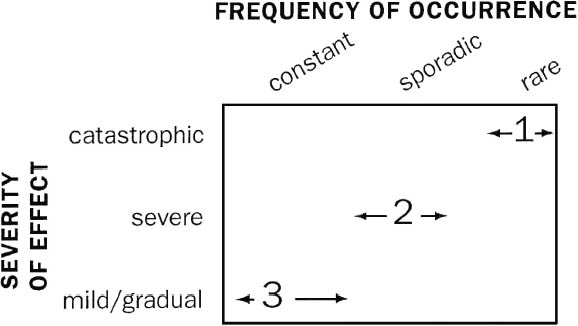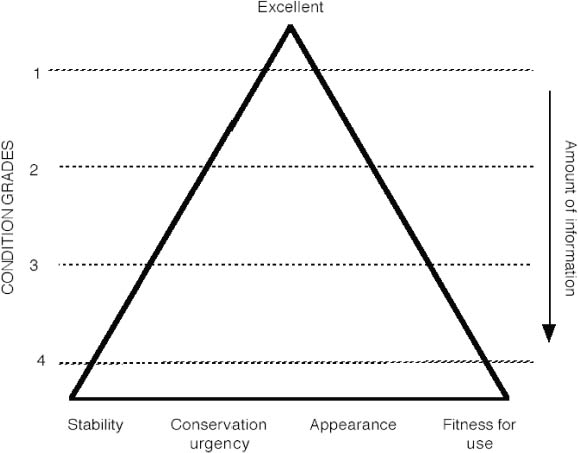AN INTEGRATED APPROACH TO RISK ASSESSMENTS AND CONDITION SURVEYSJOEL TAYLOR
2 RISK ASSESSMENTS AND COLLECTION CONDITION SURVEYSCondition surveys collect preselected kinds of information about an object's deterioration regardless of its past. Past events cannot always help to predict future ones, however (Waller 2002, 2003). Risk assessments may give an indication of the environment to which a collection is exposed. Without knowing the collection's condition, collections management decisions created by assessing risk are not necessarily based on what is affecting the collection but on what might affect the collection or what control is not in place.
Waller (2002) maintains that risk management or assessment should not be interpreted on the basis of collection condition, arguing through the case of a stray bomb damaging a collection in a highly unpredictable way as evidence (after Crumly 1984). Waller (1994) has divided risks into three separate types, based on their severity and frequency (fig. 1). These risk types fall into one of two categories when assessing probability of damage to collections (Waller 1994, 2003), referred to as “catastrophic” and “deterministic” risks by Ashley-Smith (1999). Collection information may not inform assessments of catastrophic risks, but evidence of deterministic risks is often created during a collection's exposure to environmental hazards, if Waller's hypothetical example of a risk assessment (1999) using pollutants did not involve assessment of condition or stability, although the probability of damage was considered to be certain (probability of 1) for all the pollutants assessed (Waller 1999). This certainty of damage is the case for all type 2 and type 3 risks (Waller 2003). Inferring risk of deterioration from data at any level is based on a theoretical framework of environmental conditions that are suitable or unsuitable for the preservation of objects. It is this theoretical framework within which risk assessments and condition surveys often operate (e.g., Thomson 1986; Michalski 1990, 1994; Erhardt and Mecklenburg 1994; Marcon 1997). The information recorded is conceptual, based on an understanding of how objects deteriorate, using indicators recognized within the framework to help make inferences for collection or risk management. However, Ashley-Smith (2000) points out that there is not a direct relationship between the potential for deterioration and actual deterioration. Not using evidence that a collection might provide means that the theoretical framework of deterioration is preferred over the actual interactions between a collection and its environment. Risk assessment requires effect to be inferred from cause in a similar way that condition surveys require cause to be inferred from effect. Condition surveys can be used to determine past causes from existing effects (Keene 1991, 2002) and risk assessments forecast possible effects from potential causes (Waller 1994, 2002). “Conservators are repeatedly confronted by damaged objects and are in a position to build a formal or anecdotal database relating condition to probable cause of deterioration” (Ashley-Smith 1997, 123). As Ashley-Smith (1999) and Waller (2002) state, condition surveys often record effects rather than probable causes, so using condition surveys for preventive purposes can be difficult, because damage may have already occurred and not be related to current risks.Taylor and Watkinson (2003) point out that damage categories do not always reflect a particular hazard or set of hazards. And when the damage relates to more than one category, the interpretive possibilities increase and can lead to uncertainty in interpretation.
However, both kinds of inference are based on the theoretical framework that has been created for conservation, particularly interactions based on the agents of deterioration set out by Michalski (1990). Condition surveys are “backward-looking” (Waller 2002, 104), yet provide information about actual rather than predicted damage. Risk assessments are speculative but do not require damage for interpretation. Both are assessments of a situation at a particular point in time. Looking at the whole history of a collection's condition does mean that fortune, and objects' existences before their museum accession, will be assessed as part of the museum's preservation function. However, Keene (2002) states that various “elements” contribute to a condition score (fig. 2), including “stability,” which is related to the visible interaction of the object with various hazards. Condition surveys can reveal evidence of ongoing deterioration from deterministic hazards (Johnsen 1999), such as RH, visible and UV radiation, and pollutants, as well as objects' inherent instability.
Condition surveys can even be used to show that no deterioration has occurred, and have been used to justify existing preventive conservation procedures (Johnsen 1999). This is not to say that risk assessments do not involve looking at the collection, or that condition surveys do not involve prediction, but the methods are not often connected. It is important to know whether exposure to a hazard and object condition are related. Van der Reyden et al. (1996) have used both in assessments of drawings in an Angel project that created a system of matrices, including use, exposure, condition, and risk, to prioritize preservation needs. This system was developed to give priorities to the needs of different collections, so no diagnostic link between the kind of risk and kind of damage was intended. Johnsen and Bonde-Johansen (2002) used condition surveys and time-weighted preservation indices (TWPI) to determine the most suitable storage locations for objects based on life expectancy for planning, but the survey was not intended to assess risk. Other condition assessments involving risk have looked at risk to single objects rather than to collections (Eden et al. 1998). Risks are often external, especially type 1 risks, such as floods, or very hard-to-make predictions from single objects, such as environmental risks. Assessing risk to objects at an item-by-item level may be possible for some kinds of chemical stability, but it is limiting for many risks and objects and cannot detect future changes or reveal a complete picture (Waller 2003). In brief, it could be argued that risk assessments are more suitable for catastrophic, type 1 risks, and condition surveys for deterministic, type 3 risks. |

